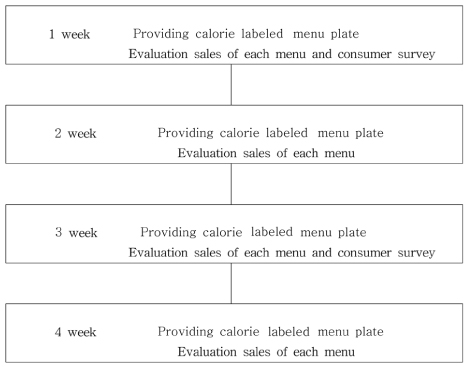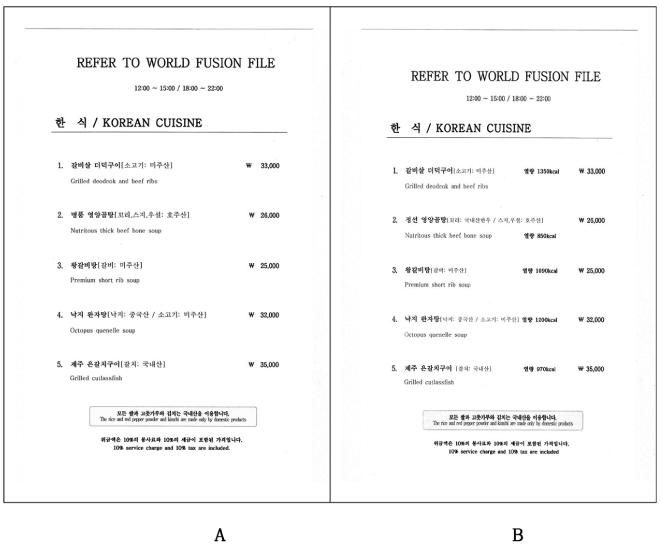Korean J Community Nutr.
2013 Oct;18(5):505-514. 10.5720/kjcn.2013.18.5.505.
Effect of Menu Calorie Labels on Menu Sales and Consumer's Recognition at a Korean Restaurant in a Hotel
- Affiliations
-
- 1Department of Food and Nutrition, Kangwon National University, Samcheok, Korea.
- 2Department of Food and Nutrition, Korea National University of Transportation, Chungbuk, Korea. mhkim1129@ut.ac.kr
- KMID: 2267559
- DOI: http://doi.org/10.5720/kjcn.2013.18.5.505
Abstract
- Effect of Menu Calorie Labels on Menu Sales and Consumer's Recognition at a Korean Restaurant in a Hotel The role of calorie information is to help consumers make healthier food choices. However, calorie information is generally unavailable in restaurants. Even in high-end hotel restaurants, which try to provide high quality foods and service, calorie labeling is not mandatory. Therefore, the purpose of this study was to evaluate the effect of calorie labeling on menu sales and consumer's recognition at a Korean restaurant in Kangwonland hotel. The calorie contents of 10 dishes sold in the restaurant were calculated using the food composition table. After making a new menu plate displaying calorie information, the new menu plate and old menu plate were provided every other week for 4 weeks. When we compared the sales between the periods of calorie labeled and calorie unlabeled, sales of 4 items among the 5 food items providing less than 1000 kcal, increased, however the 3 items among the menu providing more than 1000 kcal decreased. As the survey results of total 405 consumers (male n = 232, female n = 173) showed the new menu plate, 68.2% of subjects recognized calorie labeling on the menu plate. Among the subjects who recognized calorie labeling, 58.3% answered that calorie information affected their food choices. And most of them answered that they chose lower calorie foods based on the information provided. The results suggest that displaying calorie information on the menu plate at a Korean restaurant was effective in changing consumer's food choices.
MeSH Terms
Figure
Cited by 3 articles
-
Energy Content Estimation by Collegians for Portion Standardized Foods Frequently Consumed in Korea
Jin Kim, Hee Jung Lee, Hyun Jung Lee, Sun Ha Lee, Jee-Young Yun, Mi-Kyeong Choi, Mi-Hyun Kim
Clin Nutr Res. 2014;3(1):24-32. doi: 10.7762/cnr.2014.3.1.24.Perception and importance for country-of-origin labeling at restaurants in college students in Jeju
Yeong-Mi Park, Yang-Sook Ko, Insuk Chai
J Nutr Health. 2018;51(2):177-185. doi: 10.4163/jnh.2018.51.2.177.Customer perception and expert assessment in restaurant food environment by region – Focused on restaurants in Suwon, Hwaseong city -∗
Mi Hyun Oh, Jeong-sook Choe, Young Kim, Sang Eun Lee, Hee Young Paik, Mi Jin Jang
J Nutr Health. 2014;47(6):463-474. doi: 10.4163/jnh.2014.47.5.463.
Reference
-
1. An HJ. Consumer awareness and demand relating country of origin labeling on restaurants. Sookmyung Women's University;2009. 15. MS thesis.2. Byeon JS. Survey on nutrients in meal served, consumed and unconsumed food in Korean restaurants-based on Koreans restaurants in Changwon city and in luxurious hotels in Seoul. Changwon National University;2003. 10. MS thesis.3. Cardelo AV, Schutz H, Snow C, Lesher L. Predictors for food acceptances, consumption and satisfaction in specific eating situation. Food Quality and Preference. 2000; 11(3):201–216.4. Choi BK. A study on the influence of food service companies' nutrition indication on menus upon consumer's purchase attitudes. Kyonggi University;2009. 3. 61. MS thesis.5. Chung EJ, Jeon JS, Ahn HS. Reading and understanding of food & nutrition labels and dietary behaviors of female middle and high school students. J Korean Diet Assoc. 2010; 16:239–254.6. Chung HJ. The recognition and requirement of nutrition labeling in fast-food restaurants. Korean J Nutr. 2009; 42:68–77.7. Dumanovsky T, Huang CY, Nonas CA, Matte TD, Bassett MT, Silver LD. Changes in energy content of lunchtime purchases from fast food restaurants after introduction of calorie labelling: cross sectional customer surveys. BMJ. 2011; 343:d4464.8. Hwang YJ. Recent trends and implications for food supply. 2012. 36:p. 1–16.9. Kang HN, Shin EJ, Kim HN, Eom KY, Kwon KI, Kim SY, Moon GI, Kang BW, Kim JW. Food nutrition labeling (processing food, food service business) in Korea. Food Sci Ind. 2011; 44(1):21–27.10. Kim ST, Cho YB. A study on the menus choosing behavioral factor of restaurant in customer hotels. Korean J Culin Res. 2007; 13(1):41–54.11. Kim JH. The customer awareness and necessity about nutrition labeling system implementation of the menu. -family restaurant. Woosong University;2009. 48–49. MS thesis.12. Lee KJ, Lee YH. Consumers recognition and using state about food-nutrition labeling system among twenties. J East Asian Soc Diet Life. 2004; 14:54–63.13. Ministry of Food and Drug Safety. Nutrition composition table for eating out 2. 2013. p. 18–20.14. Ministry of Food and Drug Safety. Nutrition composition table for eating out. 2012. p. 24–110.15. Ministry of Food and Drug Safety. Special act on the safety management of children's dietary life. 2010a. cited 2013 July 10. Available from http://www.law.go.kr/LSW/lsInfoP.do?lsiSeq=98630#0000.16. Ministry of Food and Drug Safety. Enforcement ordinance of special act on the safety management of children's dietary life. 2010b. cited 2013 July 10. Available from http://www.law.go.kr/LSW/lsInfoP.do?lsiSeq=103263#0000.17. Ministry of Health and Welfare, The Korean Centers for Disease Control and Prevention. Korea health statistics 2011: Korea national health and nutrition examination survey (KNHANES V-2). 2012.18. Mokdad AH, Serdula MK, Dietz WH, Bowman BA, Marks JS, Koplan JP. The spread of the obesity epidemic in the United States, 1991-1998. JAMA. 1999; 282(16):1519–1522.19. Mokdad AH, Serdula MK, Dietz WH, Bowman BA, Marks JS, Koplan JP. The continuing epidemic of obesity in the United States. JAMA. 2000; 284(13):1650–1651.20. HR3590. Patient Protection and Affordable Care Act of 2010. In : 111th Cong; 2010. 148(111):p. 1001–1009.21. Roberto CA, Larsen PD, Agnew H, Baik J, Brownell KD. Evaluating the impact of menu labeling on food choices and intake. Am J Public Health. 2010; 100:312–318.22. Rural Resource Development Institute. The 8th edition of the food composition table in Korea. Rural Resource Development Institute;2011.23. Shin ES. The recognition on nutrition labeling of restaurant menu and the status of eating out consumption of college students in Ulsan of Korea. University of Ulsan;2009. 22–23. 29MS thesis.24. Song HG. An influence on consumption toward health by the tendency of healthful menu choice in dinning-out consume. Kyunghee University;2007. 40–41. Dissertation.25. Swartz JJ, Braxton D, Viera AJ. Calorie menu labeling on quick-service restaurant menus: an updated systematic review of the literature. Int J Behav Nutr Phys Act. 2011; 8:135.
- Full Text Links
- Actions
-
Cited
- CITED
-
- Close
- Share
- Similar articles
-
- Recognition and use of Nutrition Labeling among Hamburger and Pizza Restaurant Consumers in Daejeon
- Parents' meal choices for their children at fast food and family restaurants with different menu labeling presentations
- A Survey on Customers' Perceptions of Nutrition Labeling for Processed Food and Restaurant Meal
- A Case Study for Pricing Strategy Planning of a Family Restaurant Using Price-Sensitivity Measurement
- Customers' Use of Menu Labeling in Restaurants and Their Perceptions of Menu Labeling Attributes




